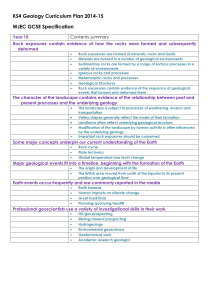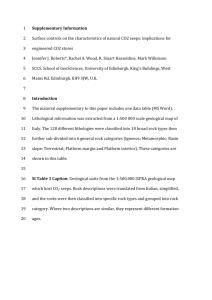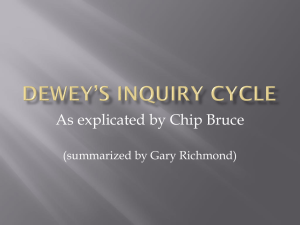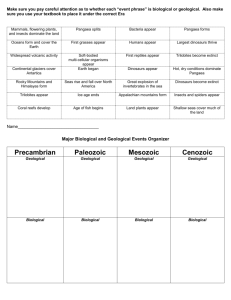PYP planner Planning the inquiry Class/grade: 4th grade Age group
advertisement
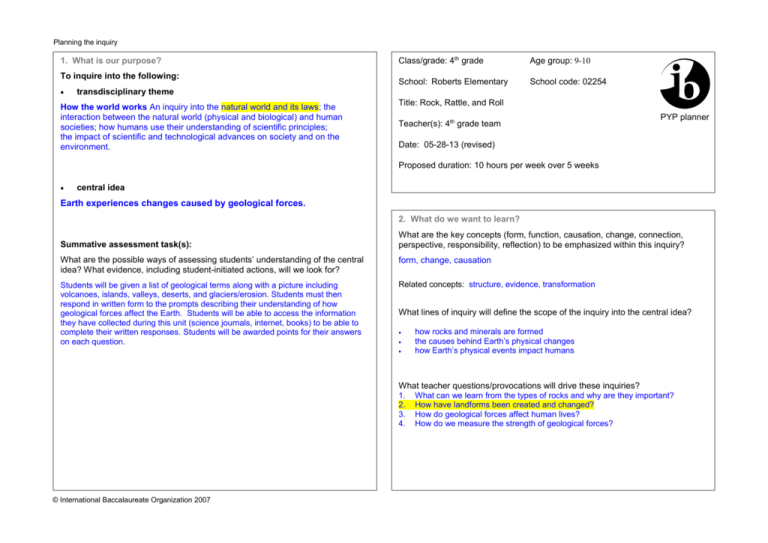
Planning the inquiry 1. What is our purpose? To inquire into the following: Class/grade: 4th grade Age group: 9-10 School: Roberts Elementary School code: 02254 transdisciplinary theme How the world works An inquiry into the natural world and its laws; the interaction between the natural world (physical and biological) and human societies; how humans use their understanding of scientific principles; the impact of scientific and technological advances on society and on the environment. Title: Rock, Rattle, and Roll Teacher(s): 4th grade team PYP planner Date: 05-28-13 (revised) Proposed duration: 10 hours per week over 5 weeks central idea Earth experiences changes caused by geological forces. 2. What do we want to learn? Summative assessment task(s): What are the key concepts (form, function, causation, change, connection, perspective, responsibility, reflection) to be emphasized within this inquiry? What are the possible ways of assessing students’ understanding of the central idea? What evidence, including student-initiated actions, will we look for? form, change, causation Students will be given a list of geological terms along with a picture including volcanoes, islands, valleys, deserts, and glaciers/erosion. Students must then respond in written form to the prompts describing their understanding of how geological forces affect the Earth. Students will be able to access the information they have collected during this unit (science journals, internet, books) to be able to complete their written responses. Students will be awarded points for their answers on each question. Related concepts: structure, evidence, transformation What lines of inquiry will define the scope of the inquiry into the central idea? how rocks and minerals are formed the causes behind Earth’s physical changes how Earth’s physical events impact humans What teacher questions/provocations will drive these inquiries? 1. 2. 3. 4. © International Baccalaureate Organization 2007 What can we learn from the types of rocks and why are they important? How have landforms been created and changed? How do geological forces affect human lives? How do we measure the strength of geological forces? Planning the inquiry 3. How might we know what we have learned? 4. How best might we learn? This column should be used in conjunction with “How best might we learn?” What are the learning experiences suggested by the teacher and/or students to encourage the students to engage with the inquiries and address the driving questions? What opportunities will occur for transdisciplinary skills development and for the development of the attributes of the learner profile? What are the possible ways of assessing students’ prior knowledge and skills? What evidence will we look for? How rocks and minerals are formed: Students will write a paragraph/illustration of how they think rocks are formed. The causes behind Earth’s physical changes: students will be given the pieces of a Pangaea puzzle to try and figure out how the continents fit together. How earth’s physical events impact humans: http://www.iknowthat.com/mhscience/Earthquakes/Fixed.htm Students will adjust the Richter Scale on this website to visualize the amount of destruction as it relates to the scale. Students will also look at pictures from places hit by earthquakes and form ideas of how people have to adapt to their different surroundings. What are the possible ways of assessing student learning in the context of the lines of inquiry? What evidence will we look for? *After learning about mountains and how they are formed, students will look at pictures of mountains and then describe in short answers how they think they were formed. *Students will be given a quiz over material discussed and read in class. * A rubric will be used in Science Lab to assess students’ participation, attention, and written responses. * Students will keep an interactive Science Journal for reflections during lab experiences. *After reading an article, students will reflect in writing on their thinking about how Pangaea broke apart versus current scientific theories. *Frontloading - students make puzzle pieces to recreate Pangaea *View Ring of Fire (iMax) video. Students will inquire about volcanoes. *Have students observe different types of rocks and minerals, then discuss similarities and differences. *Students compare location of tectonic plates with location of mountain ranges. Students will use Milky Way bars to visualize the different types of shifting of plate tectonics. *Science Lab Experiments – identifying rocks and minerals (hardness, color) rock layers – sedimentary tube ; layering of sediments (rock cycle) – Chocolate Rocks weather and erosion – Streams; earthquakes and volcanoes glaciers –ice cube model/ marshmallow *Create an illustration of the rock cycle. *Technology – use United Streaming and Brain Pop to take students on a virtual fieldtrip with images and video of landforms, rocks, etc. *Students will create an E- book or movie maker presentation of 1 geological force of student choice explaining what the force is, how it was created, and the impact of the force. Students will then present their project orally to the class. *After viewing photographs of types of erosion, students will create before/after illustrations of the impact of erosion on the earth. * Students will read an article about island formation (Birth of an Island) and the earth’s changes over time and then create a 4-6 frame cartoon illustrating how an island is formed. * During a class discussion, fossils will be compared with the layers in a laundry hamper. What opportunities will occur for transdisciplinary skills development and for the development of the attributes of the learner profile? Transdisciplinary Skills: research, thinking, communication Learner Profile: communicators, reflective, knowledgeable 5. What resources need to be gathered? What people, places, audio-visual materials, related literature, music, art, computer software, etc, will be available? McGraw Hill Science text, grade 4, Learning About Earth’s History; http://www.desertusa.com/ http://teach.fcps.net/trt20/projects/EKU/Default.htm Earthquake” “Birth of an Island” Ring Of Fire; Alaska (iMax) www.brainpop.com www.unitedstreaming.com How will the classroom environment, local environment, and/or the community be used to facilitate the inquiry? Guest speakers – Cin-Ty Lee – Rice University Geology Department (rocks, volcanoes) © International Baccalaureate Organization 2007 “Sumatra’s catastrophic Dec. 26th Reflecting on the inquiry 6. To what extent did we achieve our purpose? 7. To what extent did we include the elements of the PYP? Assess the outcome of the inquiry by providing evidence of students’ understanding of the central idea. The reflections of all teachers involved in the planning and teaching of the inquiry should be included. What were the learning experiences that enabled students to: On the summative assessment, our students’ work was very impressive. They had to put their thinking into their own words. They were really able to apply what they have learned and use the resources available to them to produce reasonable explanations as to how the landscape has been formed. develop an understanding of the concepts identified in “What do we want to learn?” demonstrate the learning and application of particular transdisciplinary skills? develop particular attributes of the learner profile and/or attitudes? In each case, explain your selection. How you could improve on the assessment task(s) so that you would have a more accurate picture of each student’s understanding of the central idea. We like the open ended aspect of the summative assessment, but there were elements on it that did not get covered during the inquiry and we may need some changes to the format of the assessment. Working in partners worked better than individually. We could create an assessment where students describe 3 out of the 5 geological forces and how they affect the Earth. We feel it is essential that they know that the movement of the plates is what causes many of the geological forces. What was the evidence that connections were made between the central idea and the transdisciplinary theme? During the summative assessment, the students were able to describe their thoughts on how the earth is continually changing and that this is an on-going process. The students were able to explain that this is how the world works and that this will continue to occur. Concepts: The concepts of form, causation, change were focused on during this unit. During this unit, students learned about how the Earth was formed and how it continues to be changed. They explored the causes for the changes through science lab experiences, as well as video and reading material. Transdisciplinary Skills: The students worked on the following skills: research, thinking and communication. Throughout the unit they developed their research skills as they learned about landforms and rock formations. They used the internet, video footage, and a speaker to gather information. As this was new information to many of the students, they had to use their critical thinking skills to develop an understanding of the Earth they take for granted. Communication skills were necessary developing and presenting their movie/eBook on geological forces. Learner Profile: The students focused on the following Learner profile attributes: communicator, reflective, knowledgeable. Students communicated their learning through oral and digital presentations. They became more reflective about their explorations by using their interactive science journal and gained new knowledge throughout the unit. © International Baccalaureate Organization 2007 Reflecting on the inquiry 8. What student-initiated inquiries arose from the learning? 9. Teacher notes Record a range of student-initiated inquiries and student questions and highlight any that were incorporated into the teaching and learning. It would be great to add the Yellowstone iMax and the book Through the Volcano. We would like to be able to show a movie to the fourth grade students once a week. If scientists know about Pangaea, how come they don’t know about when tornados will happen? If black sand is made from a volcano, how is the white sand formed? We would like to include more opportunities for how the geology and geography affect the lives of humans – examples patterns of settlement, specific lifestyle changes. When does an earthquake end? How do seismographs and seismic waves help humans keep safe? Why do earthquakes sometimes last longer than others? How come some of the most dangerous earthquakes last only a few seconds? Why do people invent stories to explain how the world works? Why do paleontologists need to know about biology, ecology, geology, and archeology? Why do rock formations have different shapes? The Rock Cycle: http://www.learner.org/interactives/rockcycle/ Why are there earthquakes? How do you know how old fossils are? How are mountains and landforms formed? At this point teachers should go back to box 2 “What do we want to learn?” and highlight the teacher questions/provocations that were most effective in driving the inquiries. What student-initiated actions arose from the learning? Record student-initiated actions taken by individuals or groups showing their ability to reflect, to choose and to act. Students brought in rock collections from home. They also tried to name rocks they had found in their environment. Students brought in newspaper clippings on a regular basis about geological events in the world. Several students shared photographs from family field experiences connected to the central idea. Students initiated research projects. © International Baccalaureate Organization 2007 Everyday activities that we did this year: - Teacher Tube “da rock cycle” video (Watchknowlearn.org) - Neok12: volcano features matching smart - Volcano demo: baking soda, jello mix, vinegar - Playdough Mountain (4 forms) - Milky Way Plate Tectonics - Rock Cycle song, poster or poem Soil/Erosion/Deposition: http://hpms.hpisd.org/Portals/1/Teachers/Yergler/weathering,%20erosion,%20deposi tion%20notes.ppt (PowerPoint) Earthquakes/Volcanoes/Tsunamis: http://www.iknowthat.com/mhscience/Earthquakes/Fixed.htm http://video.nationalgeographic.com/video/news/environment-news/japan-tsunami2011-vin/?source=vidcarousel Earth’s Compositon/Plate Tectonics/Pangaea: http://www.ducksters.com/science/composition_of_the_earth.php http://www.kidsgeo.com/geology-for-kids/0020-crust-mantel-core.php http://www.kidsgeo.com/geology-for-kids/0043-plate-tectonics.php http://platetectonicsforkids.com/ http://www.kidsgeo.com/geology-for-kids/0042-pangaea.php
